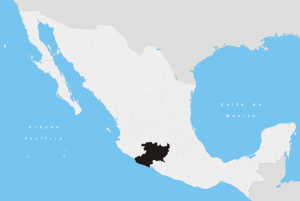Cotija de la Paz

Cotija is a municipality located in the Mexican state of Michoacán. The municipality has an area of 504.05 square kilometres (0.91% of the surface of the state), and is bordered to the north by Jiquilpan and Villamar, to the east by Tocumbo, and to south by the state of Jalisco. The municipality had a population of 18,207 inhabitants according to the 2005 census.[1] Its municipal seat is the city of Cotija de la Paz (pop. 12,453).[2]
Cotija is the birthplace of several religious figures, including Saint Rafael Guízar Valencia and Father Marcial Maciel. The economy of the municipality is mostly based on agriculture and ranching.[3] Cotija cheese is named after the city.[4]
The municipal president of Cotija and its many outlying communities is José Mendoza Morfín in 2008.[5]
History
There are different versions regarding the founding date of Cotija. The Reverend Jose Romero places the founding between 1575 and 1576, in a site called Cotixa, which was situated near the Rio Claro (Clear River), Mr. Melchor Manzo de Corona built what became the first Spanish settlement in the region. From 1581 to 1595, 11 other Spanish colonists joined Corona in Cotixa. Some built their houses, they attempted to make a living by raising cattle. Other Spanish families arrived. At the time, this Spanish settlement was known as the Rincon de Cotixa (Cotixa Nook) and Mr. Melchor Manzo’s hacienda was considered the heart of the settlement. A primitive chapel was constructed in honor of Our Lady of the Pópolo, where a flea market (tianguis) was held on Sundays. By 1730, the chapel of the Rincon de Cotixa had a standing priest, but baptisms, marriages and burials were not allowed. Therefore, it was necessary to travel to the town of Tinguidin for those religious affairs. This situation was not remedied until November 1740, when the Bishop of Michoacán, Fr. Marks Ramirez of the Prado, gave permission to the chapel of the Rincon de Cotixa to perform ecclesiastical burials. Between August 2 and 5, 1759, Francisco Antonio de Echavarri decreed that the Rincon de Cotixa and the Llano of Titiacoro would be united and officially renamed as the Congregation of Cotija. In 1790, Cotija was reclassified as a city by Michoacán governor, Aristeo Mercado.
Notable people
- Marcial Maciel Degollado, founder of the global Catholic order Legion of Christ
- José Ma. Mendoza Pardo, politician
- Gilberto Chávez García (1875 - )
- Gilberto Chávez González
- Benigno Trejo
- Jesús Degollado Guízar
- José González Torres
- Jesús González Valencia
- Jesús Sahagún de la Parra, Bishop
- José Rubén Romero Gonzalez, writer and Mexican diplomat (1890–1952)
- Rafael Guízar Valencia, Bishop and Saint (1877–1938)
- Rafael Reyes, artist/singer (Prayers: Cholo goth duo)
- Mario Moreno Reyes (Cantinflas), actor (1911–1993) (see note below)
- José María González y Valencia, Archbishop 1884-1958)
- Felipe Arriaga, singer/actor
- Francisco Diaz Mendoza (1925–1996)
Note: Cantinflas was born in Mexico City, but his mother was born in Cotija.
External links
References
- ↑ Instituto Nacional de Estadística, Geografía e Informática (INEGI). "2005 Census". Archived from the original on 2013-02-27. Retrieved 2007-09-14.
- ↑ Map of Cotija de la Paz, Michoacán, as retrieved on 2006-12-18
- ↑ Cotija Actividad Económica (in Spanish)]
- ↑ Article on Cotija cheese and its namesake town as retrieved on 2006-12-18.
- ↑ Cambio de Michoacán "Autoridades intentan fraccionar área de donación en Cotija". Retrieved 2007-09-14.
Coordinates: 19°49′N 102°41′W / 19.817°N 102.683°W
